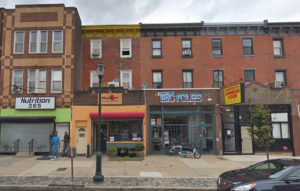Graphic Design and Gentrification: Is There A Link?: Part 1
Gentrification Comes in the Form of Promises and Opportunities Communicated by Visual Communication
I remember seeing the real estate signs in the community and thinking how odd this was. During the 1970s, my section of North Philadelphia was a vibrant fragile community populated with poor and working class African Americans. I spent most of my childhood years on Uber Street bound between Susquehanna Avenue and Diamond Street. ‘The avenue’ as we called it was teeming with diverse Black businesses which also included emerging Asian merchants. The motley crew I hung with was watched over by married couples, single parents and retired folks This kind of North Philly love never made it on the evening news. But in the 1980s, the emergence of open air drug markets, increased violence and community disinvestment began destroying the community, its reputation and countless lives. By the time the Crack epidemic leveled off in the 1990s, my old neighborhood was viewed as a wasteland. I had graduated from college and moved to Lancaster, PA to take my first graphic design job. I thought my neighborhood was gone forever and I had no plans of moving back. But after seven years at an international nonprofit, I felt a deep desire to return. President Clinton’s Empowerment Zones were designated for distressed communities in America’s large urban centers. Enacted in 1993, its goal was economic rejuvenation and job creation through tax incentives and grants. My native North Philadelphia was one of the primary recipients. I was hoping to tap into the funds allocated for my own businesses. It was around this time that I saw this sign below on many abandoned rowhouses in the neighborhood:

Today, critics argue that the empowerment zones did not fully benefit my section of North Philadelphia but it did assist Temple University’s expansion efforts. There was not enough on-campus housing for its growing mostly White student body which provided an opportunity for small and large real estate developers to begin buying abandoned properties. They renovated them and charged a premium price for rent. So IMHO, the gentrification in my old neighborhood was sparked by a higher education institution who had been wanting this for years. Over the years, credible accusations were also made against other urban campuses in Philadelphia like University of Pennyslvania and LaSalle University. Temple University’s behind-the-scenes maneuvers eventually brought neighborhood change favorable to their goals but for someone like me who left and came back, it was the visible Coldwell Banker real estate signs that initially gave it away. Why? Because, at the time, this real estate franchise’s investments were primarily in large commercial areas of downtown Philadelphia, not struggling neighborhoods.
There is an ongoing argument in the African American community vacillating between identifying gentrification as racism or economics because of our history. Although I believe it has been both in the past, I lean towards economics now because other non-Black groups are also experiencing some version of it. In this commentary, I will focus my energies around the commercial aspects that follow gentrification. There are also other topics to consider such as ethnicity, culture, history and geography. I also admit my skepticism about the benefits of gentrification for poor and working class communities of color. Right now, I am simply trying to relay what I know, what I have learned and how this intersects with graphic design.
What is Gentrification?
Although this article is from 2011, I agree with its definition by Hakimu Davidson:
“A process by which middle-class people take up residence in a traditionally working-class area of a city, changing the character of the area.”
A Pew Charitable Trust report chose to document gentrification in Philadelphia using income levels because this information can be easily researched at census.gov. Although there are other aspects mentioned above that can lead to gentrification, this approach makes sense since community displacement and marginalization often happens based on income. In Philadelphia, a city of neighborhoods, displacing low income populations usually meant poor and working class Black and Brown people. Close to 50% of the overall population in Philly is African American yet 27% live in poverty. However, in the last 10 years, gentrification is also beginning to impact the native White working class in the Fishtown and Port Richmond neighborhoods. The controversial political scientist and author Charles Murray studied these two neighborhoods and wrote a book about it.
Signs of Gentrification
These are the four signs of gentrification I have observed:
- Abundant Real Estate Signs (like Coldwell Banker): They show up on abandoned buildings and will often stay there for 3-5 years. In others, they show up on residential homes where property values are soaring and housing is in demand.
- Neighborhood name change or name resurrection: Change the perception of the community to initial investors and/or affluent professionals and it is like a new neighborhood popped out of nowhere.
- Goods and services: Cafes, pet services, restaurants, tanning salons, specialty stores, police responsiveness, etc.
- Cosmetic neighborhood improvements: Paved sidewalks, improved streets, consistent landscaping, enhanced lighting, trash cans, commissioned and independent street art, etc.
There are multiple theories about why gentrification happens. My four signs above support the Consumption-Side Theory which examines the consumption habits of the affluent educated newcomers. Gentrification occurs to cater to their desires and tastes.
/cdn.vox-cdn.com/uploads/chorus_image/image/54166919/IMG_6944.0.jpeg)
Case Study: Brewerytown in Philadelphia
As the ‘workshop of the world’, Philadelphia was a major manufacturing hub with over 700 breweries operating across the city in the 19th century. Brewerytown was near the Schuylkill River and contained nine breweries in a single ten-block stretch which employed mostly German immigrants. But in the 1920s, the brewing industry collapsed because of the effects of Prohibition. Once the prohibition law was repealed, many of them relocated away from Philadelphia leaving the area an industrial wasteland. As southern Blacks migrated north for better jobs and settled in the area and in Strawberry Mansion next to it, the White residents left. By the 1980s, the community was mostly African American. As crime, blight and violence soared, many assumed that Brewerytown was a part of Strawberry Mansion which was having the same exact problems. According to an article at billypenn.com, neighbors never called it Brewerytown. In the early 1990s, once the community was certified by the National Register of Historic Places as a historical district, developers revived the name to attract young professionals. This name rebranding helped initiate a gentrification process that allowed Brewerytown to become a majority White middle class community over time as it sits next to predominantly poor and working class Black Strawberry Mansion.
I was raised with the understanding that North Philadelphia meant any area north of City Hall up to Olney Ave excluding Roxborough (northwest Philadelphia) and any neighborhoods on the southeastern side of North Philadelphia (Chinatown, Northern Liberties, Fishtown and Port Richmond). Directional names primarily identify sections of the city: North Philly, West Philly, Northeast Philly and South Philly. Within these sections are specific neighborhoods. In North Philly, there is Nicetown, Hunting Park, Francisville, Logan, Fairmount, etc. In West Philly, there is Mantua, Overbrook, Wynnefield, Parkside, University City, etc. My section was just called North Philly. Today, it is referred to as North Central Philly.
But growing up, I never heard the name Brewerytown and I was a 40 minute walk from the area. My mother occasionally shopped on GIrard Avenue (see 2nd photo below) near 29th Street when I was a child. This area was referred to as North Philly or Strawberry Mansion. While in college in the late 1980s, I remember a white friend of mine (who was not from Philly) mentioning Brewerytown in North Philly. I was completely confused. Where was this Brewerytown?

This commercial corridor (above photo) that borders Brewerytown now has a bicycle shop and a gourmet burger spot. However, next door are remnants of the type of businesses that were once the majority here: The Chinese fast-food store sign. (This is screenshot from Google maps so I do not know how old it is. But it looks like the space is being renovated and will probably become something else.)
These four ways listed above have one thing in common: the utilization of Visual Communication. The use of graphics, text and images in commercial areas can give us some indicators of the economic capital and purchasing power of a community. Visual culture would include commercial signs, paint (new or deteriorating) on buildings, building and sidewalk maintenance, storefront design, landscape design, advertising, graphic design, types of stores, etc. The use of advertising and graphic design did exist in low income neighborhoods before the arrival of premium cafes and specialty stores. But it is a different type of visual culture.
What do you think?